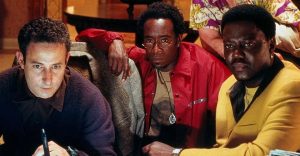The Last Kingdom: 5 Things That Are Historically Accurate (And 5 Things That Are Completely Wrong)

The Last Kingdom follows the story of Uhtred, an English boy whose kingdom is conquered by the Danes and his family murdered. Earl Ragnar, a well-respected Danish warrior, then takes Uhtred as his ward, eventually adopting him. While living a Danish lifestyle from that moment on with his adopted family, Uhtred’s loyalties are brought into question when his treacherous uncle attacks his new family, and King Alfred of Wessex decides that Uhtred may come in handy if brought into his service.
Based on true events that lead to the formation of England, this series draws on many historical milestones to make for some compelling storytelling, however not every aspect of the series is historically accurate. Let’s take a look at some important aspects of this series that may surprise you with regards to their authenticity.
RELATED: 10 Shows To Watch If You Liked The Last Kingdom
10. Accurate: King Alfred

He really was the ruler of Wessex during this time period, having ascended the throne in 871. While there are subtle differences between the real life Alfred and the character portrayed in the series, his important character traits are mostly mirrored by the fictional Alfred.
This includes the chronic pain that he suffered from, which many historians believed could be a result of Crohn’s disease. As was the case with the historical King Alfred, the fictional version was a staunch supporter of the church and lacked any aptitude for combat.
9. Inaccurate: The Use Of The Term “Vikings”

While the Scandinavian forces who invade England and terrorize the Anglo-Saxons are referred to as both “Danes” and “Vikings” in the television series, they would not be labeled using both terms during this historical time period.
The Anglo Saxons of the time would solely refer to them as “Danes”. The term “Viking” only became popularised years after the events depicted in the series.
8. Accurate: The Battle Of Edington

In the Season 1 Finale, Uhtred leads King Alfred’s forces in a battle against Gunther and his hordes. Some aspects of the battle have been fictionalized, such as how in reality, the Danes were driven into a fort and then besieged, whereas in the series, they were outright defeated in the field of battle.
Overall, the important aspects of the battle that had far-reaching consequences remained the same. This includes Alfred summoning his allies to join him in battle, and the eventual victory of Alfred’s forces over the Danes.
7. Inaccurate: Uhtred

The Uhtred we see in the wars between the Saxons and the Danes is a fictional character, however, he is based on Uhtred the Bold, who is yet another brave warrior. There are numerous similarities between the two figures, such as the blood feuds they were involved in, for example, the murder of Uhtred’s adoptive father and the treachery of his uncle.
Despite such similarities, the real-life Uhtred lived after the events of the series, in the 10th and 11th centuries, making the timeline of fictional Uhtred historically inaccurate.
6. Accurate: Relations Between Wessex And Cornwall

With Wessex sharing a border with Cornwall, many cross-border raids were carried out, and a war between the two kingdoms occurred. Although the Cornish accepted defeat and abandoned military activities against Wessex, Alfred had little control over Cornwall. He merely owned a few estates in the north-east.
This lack of power is depicted in the television series as well, and so is the Tamar, which is the border between Wessex and Cornwall. Furthermore, the series’ depiction of the Cornish as traders is entirely credible, with channels connecting them with the Irish and Welsh to the north and the Bretons to the south.
RELATED: 20 Mistakes Fans Missed In Vikings
5. Inaccurate: The Shield Wall Formation

In the television series, the shield wall that is used by the Danes is depicted as a three or four layer wall of shields that completely conceals the front line of soldiers. In reality, the shield wall consisted of men standing side by side and overlapping their shields with one another.
Secondly, the depiction of the Saxons’ unfamiliarity with the shield wall and Uhtred’s later training of the Saxon forces in shield wall tactics is also historically inaccurate. In reality, the Saxons used the shield wall as a standard tactic for centuries, and Uhtred’s father’s forces would not have been taken by surprise by the Danes as was the case in the series’ premiere.
4. Accurate: The Supporting Characters

On the Danish side, the warlords Ubba and Earl Guthrum were both historical figures. King Alfred’s family, including his wife Eahlswith, son Edward and nephew Aethelwold, were all historical figures as well as Alfred’s appointed officials in Wessex such as Odda and his son.
Asser the Monk is also a historical figure, and his loyalty to Alfred which he displayed by confessing Uhtred’s betrayal to him is credible, due to the historical Asser having written a biography about him. The only possible discrepancy is that this Welsh monk was portrayed with an English accent on the TV series.
RELATED: THE LAST KINGDOM SEASON 3 TO PREMIERE ON NETFLIX IN NOVEMBER
3. Inaccurate: The Weapons Used

The series shows both the vast majority of Danish and Saxon armies using swords as their primary weapon in battle. In reality, the use of swords was extremely rare during this time period, as swords were typically viewed as being a status symbol for the wealthy as well as those of high military ranking.
Spears and axes were far more popular weapons of choice, as not only were they easier to learn how to use than swords, but they were far more freely available for common folk to purchase. In fact, many people would already possess axes or spears as household items.
2. Accurate: The Lingo

The term “arseling“, which meant “from the ass”, was used byLeofric to tease his friend Uhtred on the television series. This term was, in fact, prevalent during the time period of this series. Another commonly used phrase on the show, plowing the field, which had a sexual connotation, was also historically commonplace.
Many of the towns featured in the show, such as London, Reading, and Winchester, were labeled on-screen with both their modern and their Anglo-Saxon names of the time, thus accurately depicting their names in both time periods.
1. Inaccurate: Leofric’s Accent

The character Leofric was one of King Alfred’s main military commanders and an ally to Uhtred, and whilst their relationship was hostile at first, he later became one of Uhtred’s close friends. Naturally, Leofric is meant to be native to Wessex, however, his accent does not exhibit this.
Leofric is portrayed with a heavy Yorkshire accent, which would suggest that he actually comes from the North. Strangely enough, Uhtred the Elder, who was from Northumberland, had a southern accent on the show.
NEXT: 10 Best Historical Dramas To Stream On Netflix
About The Author

















